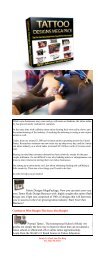Remote Learning Guidance
Create successful ePaper yourself
Turn your PDF publications into a flip-book with our unique Google optimized e-Paper software.
Health and Wellness
The health and wellness of all Illinois staff and students is the fundamental priority at this time.
Health and safety concerns are paramount in all work that must be done in person or in a
specific place. With remote learning and work schedules for many adjusted, health is an even
more important foundation for adults and children to be ready to engage with the world. Below
are some recommendations districts can provide to their stakeholders to support the health and
safety of district staff members, families, caregivers, and students:
• Underlying Health Conditions: Talk with staff and families of children who have
medical diagnoses (chronic lung disease, moderate to severe asthma, serious heart
conditions, immunocompromised, undergoing cancer treatment, severe obesity,
diabetes, kidney failure) to reinforce the importance of checking in with their primary
doctor about health maintenance at this time and emphasize the importance of having
enough of their prescription medications available.
• COVID-19: Encourage parent communication with primary care providers about how
COVID-19 may impact their child’s health. Should parents suspect a Covid-19 infection,
they should review with their provider the signs, symptoms, and treatment for their child,
including what constitutes a medical emergency where immediate 911 attention would
be warranted.
• Primary Care Givers: If the family’s child doesn’t have a primary care provider, they
should contact https://www.illinois.gov/hfs/MedicalPrograms/AllKids/Pages/default.aspx
or 1-866-ALL-KIDS (1-866-255-5437).
• Diet: Students and staff should eat three healthy meals a day that include fruits,
vegetables, and protein. Families that are having difficulty getting sufficient meals should
look to possible resources from schools or local government. Avoid unhealthy snacking
to alleviate stress. Teachers should encourage parents to allow their children to
participate in meal preparation to encourage healthy eating habits.
• Sleep Guidelines: Students aged 3 – 5 years old need 11 to 13 hours of sleep.
Students aged 5 – 10 years old need 10 to 11 hours. Students aged 11 – 18 years old
need 9 to 10 hours
• Exercise: Gross motor movement is more important now than ever but can also be
more difficult to achieve with an adjusted schedule and social distancing. Children and
adolescents age 6 and older need at least an hour a day of physical activity. Most of the
hour should be either moderate or vigorous aerobic activity. Vigorous activity should be
included at least three days a week. Parents should keep social distancing in mind when
arranging for physical activity, and some may not have access to a safe place to do this.
At the very least, a vigorous walk around their neighborhood where active conversation
occurs about their immediate environment (houses, trees, animals, neighbors) or a
developmentally appropriate conversation about what is going on in the world and why
it’s so different from the norm. Other examples of moderate activity are sweeping the
floor, walking briskly, dancing, vacuuming, washing windows, yardwork. More vigorous
activity could involve a bike ride, playing tag with siblings or parents, and taking the
family dog for a run.
• Hydration: An altered schedule and environment where students aren’t walking by a
drinking fountain several times a day mean that it is more difficult for them to stay
12




